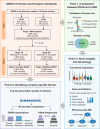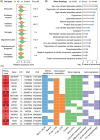Genome-wide meta-analysis identifies ancestry-specific loci for Alzheimer's disease
- PMID: 39023044
- PMCID: PMC11497642
- DOI: 10.1002/alz.14121
Genome-wide meta-analysis identifies ancestry-specific loci for Alzheimer's disease
Abstract
Introduction: Alzheimer's disease (AD) is a devastating neurological disease with complex genetic etiology. Yet most known loci have only identified from the late-onset type AD in populations of European ancestry.
Methods: We performed a two-stage genome-wide association study (GWAS) of AD totaling 6878 Chinese and 63,926 European individuals.
Results: In addition to the apolipoprotein E (APOE) locus, our GWAS of two independent Chinese samples uncovered three novel AD susceptibility loci (KIAA2013, SLC52A3, and TCN2) and a novel ancestry-specific variant within EGFR (rs1815157). More replicated variants were observed in the Chinese (31%) than in the European samples (15%). In combining genome-wide associations and functional annotations, EGFR and TCN2 were prioritized as two of the most biologically significant genes. Phenome-wide Mendelian randomization suggests that high mean corpuscular hemoglobin concentration might protect against AD.
Discussion: The current study reveals novel AD susceptibility loci, emphasizes the importance of diverse populations in AD genetic research, and advances our understanding of disease etiology.
Highlights: Loci KIAA2013, SLC52A3, and TCN2 were associated with Alzheimer's disease (AD) in Chinese populations. rs1815157 within the EGFR locus was associated with AD in Chinese populations. The genetic architecture of AD varied between Chinese and European populations. EGFR and TCN2 were prioritized as two of the most biologically significant genes. High mean corpuscular hemoglobin concentrations might have protective effects against AD.
Keywords: Alzheimer's disease; Asian; ancestry; genome‐wide association study; neurology.
© 2024 The Author(s). Alzheimer's & Dementia published by Wiley Periodicals LLC on behalf of Alzheimer's Association.
Conflict of interest statement
The authors declare no conflicts of interest. Author disclosures are available in the supporting information.
Figures




Similar articles
-
Interpretation of risk loci from genome-wide association studies of Alzheimer's disease.Lancet Neurol. 2020 Apr;19(4):326-335. doi: 10.1016/S1474-4422(19)30435-1. Epub 2020 Jan 24. Lancet Neurol. 2020. PMID: 31986256 Free PMC article. Review.
-
Admixture mapping reveals the association between Native American ancestry at 3q13.11 and reduced risk of Alzheimer's disease in Caribbean Hispanics.Alzheimers Res Ther. 2021 Jul 3;13(1):122. doi: 10.1186/s13195-021-00866-9. Alzheimers Res Ther. 2021. PMID: 34217363 Free PMC article.
-
A high-density whole-genome association study reveals that APOE is the major susceptibility gene for sporadic late-onset Alzheimer's disease.J Clin Psychiatry. 2007 Apr;68(4):613-8. doi: 10.4088/jcp.v68n0419. J Clin Psychiatry. 2007. PMID: 17474819
-
Polygenic Risk Score Reveals Genetic Heterogeneity of Alzheimer's Disease between the Chinese and European Populations.J Prev Alzheimers Dis. 2024;11(3):701-709. doi: 10.14283/jpad.2024.29. J Prev Alzheimers Dis. 2024. PMID: 38706286
-
Genetics of Alzheimer's disease: an East Asian perspective.J Hum Genet. 2023 Mar;68(3):115-124. doi: 10.1038/s10038-022-01050-z. Epub 2022 Jun 1. J Hum Genet. 2023. PMID: 35641666 Free PMC article. Review.
Cited by
-
Special Issue: "New Trends in Alzheimer's Disease Research: From Molecular Mechanisms to Therapeutics: 2nd Edition".Int J Mol Sci. 2025 Jul 25;26(15):7175. doi: 10.3390/ijms26157175. Int J Mol Sci. 2025. PMID: 40806308 Free PMC article.
-
Variables associated with cognitive function: an exposome-wide and mendelian randomization analysis.Alzheimers Res Ther. 2025 Jan 7;17(1):13. doi: 10.1186/s13195-025-01670-5. Alzheimers Res Ther. 2025. PMID: 39773296 Free PMC article.
References
-
- Gatz M, Reynolds CA, Fratiglioni L, et al. Role of genes and environments for explaining Alzheimer disease. Arch Gen Psychiatry. 2006;63:168‐174. - PubMed
Publication types
MeSH terms
Substances
Grants and funding
- 2022ZD0211600/Science and Technology Innovation 2030 Major Projects
- 92249305/National Natural Science Foundation of China
- 82071201/National Natural Science Foundation of China
- 82271475/National Natural Science Foundation of China
- 2018SHZDZX01/Shanghai Municipal Science and Technology Major Project
- 2022QD002/Research Start-up Fund of Huashan Hospital
- 3030277001/Excellence 2025 Talent Cultivation Program at Fudan University
- BX20230087/National Postdoctoral Program for Innovative Talents
- ZHANGJIANG LAB, Tianqiao and Chrissy Chen Institute
- State Key Laboratory of Neurobiology
- Frontiers Center for Brain Science of Ministry of Education, Fudan University
LinkOut - more resources
Full Text Sources
Medical
Research Materials
Miscellaneous

